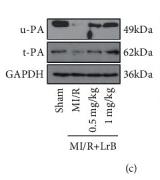IFRD1 Antibody - #DF2392
| Product: | IFRD1 Antibody |
| Catalog: | DF2392 |
| Description: | Rabbit polyclonal antibody to IFRD1 |
| Application: | WB IHC IF/ICC |
| Cited expt.: | WB |
| Reactivity: | Human, Mouse, Rat |
| Prediction: | Pig, Bovine, Sheep, Rabbit, Dog, Chicken |
| Mol.Wt.: | 50 kDa; 50kD(Calculated). |
| Uniprot: | O00458 |
| RRID: | AB_2839600 |
Related Downloads
Protocols
Product Info
*The optimal dilutions should be determined by the end user. For optimal experimental results, antibody reuse is not recommended.
*Tips:
WB: For western blot detection of denatured protein samples. IHC: For immunohistochemical detection of paraffin sections (IHC-p) or frozen sections (IHC-f) of tissue samples. IF/ICC: For immunofluorescence detection of cell samples. ELISA(peptide): For ELISA detection of antigenic peptide.
Cite Format: Affinity Biosciences Cat# DF2392, RRID:AB_2839600.
Fold/Unfold
12 O tetradecanoylphorbol 13 acetate induced sequence 7; IFRD1; IFRD1_HUMAN; interferon related developmental regulator 1; Interferon-related developmental regulator 1; Nerve growth factor inducible protein PC4; Nerve growth factor-inducible protein PC4; PC4; Pheochromocytoma cell 4; TIS7; TPA induced sequence 7;
Immunogens
A synthesized peptide derived from human IFRD1, corresponding to a region within N-terminal amino acids.
- O00458 IFRD1_HUMAN:
- Protein BLAST With
- NCBI/
- ExPASy/
- Uniprot
MPKNKKRNTPHRGSSAGGGGSGAAAATAATAGGQHRNVQPFSDEDASIETMSHCSGYSDPSSFAEDGPEVLDEEGTQEDLEYKLKGLIDLTLDKSAKTRQAALEGIKNALASKMLYEFILERRMTLTDSIERCLKKGKSDEQRAAAALASVLCIQLGPGIESEEILKTLGPILKKIICDGSASMQARQTCATCFGVCCFIATDDITELYSTLECLENIFTKSYLKEKDTTVICSTPNTVLHISSLLAWTLLLTICPINEVKKKLEMHFHKLPSLLSCDDVNMRIAAGESLALLFELARGIESDFFYEDMESLTQMLRALATDGNKHRAKVDKRKQRSVFRDVLRAVEERDFPTETIKFGPERMYIDCWVKKHTYDTFKEVLGSGMQYHLQSNEFLRNVFELGPPVMLDAATLKTMKISRFERHLYNSAAFKARTKARSKCRDKRADVGEFF
Predictions
Score>80(red) has high confidence and is suggested to be used for WB detection. *The prediction model is mainly based on the alignment of immunogen sequences, the results are for reference only, not as the basis of quality assurance.
High(score>80) Medium(80>score>50) Low(score<50) No confidence
Research Backgrounds
Could play a role in regulating gene activity in the proliferative and/or differentiative pathways induced by NGF. May be an autocrine factor that attenuates or amplifies the initial ligand-induced signal (By similarity).
Expressed in a variety of tissues.
Belongs to the IFRD family.
References
Application: WB Species: Mouse Sample: Hippocampus tissue
Application: WB Species: Mice Sample:
Restrictive clause
Affinity Biosciences tests all products strictly. Citations are provided as a resource for additional applications that have not been validated by Affinity Biosciences. Please choose the appropriate format for each application and consult Materials and Methods sections for additional details about the use of any product in these publications.
For Research Use Only.
Not for use in diagnostic or therapeutic procedures. Not for resale. Not for distribution without written consent. Affinity Biosciences will not be held responsible for patent infringement or other violations that may occur with the use of our products. Affinity Biosciences, Affinity Biosciences Logo and all other trademarks are the property of Affinity Biosciences LTD.




